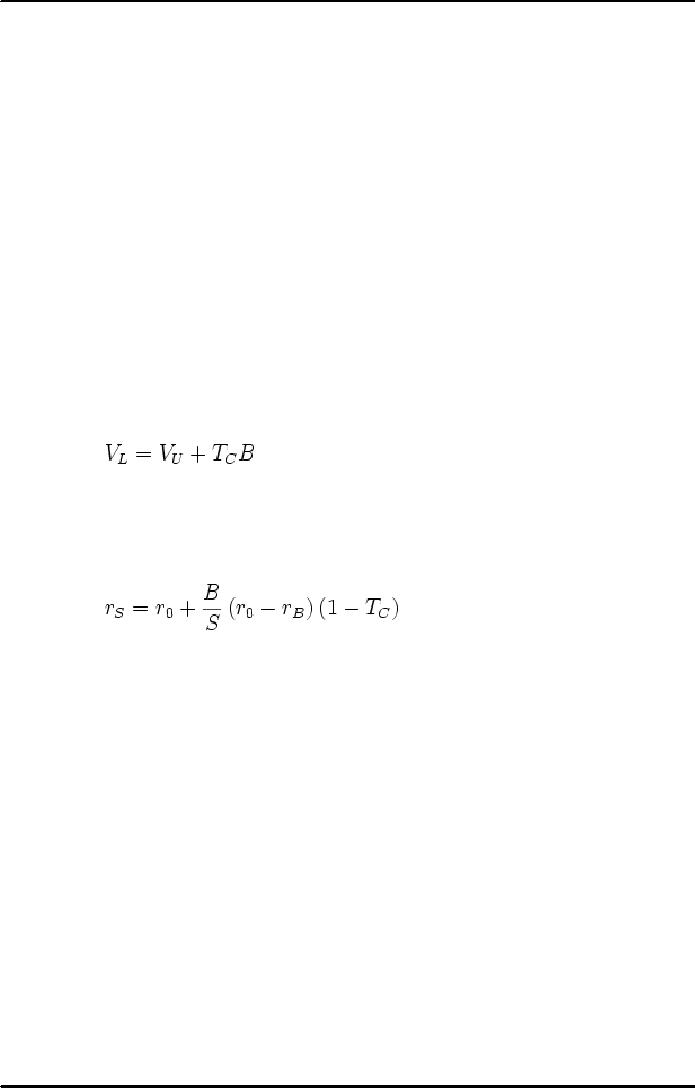 |

Corporate
Finance FIN 622
VU
Lesson
21
CAPITAL
STRUCTURE & COST OF
EQUITY
MODIGLIANI
AND MILLER MODEL
The
following topics will be
discussed in this lecture.
Home
made leverage
Modigliani
& Miller Model
How
WACC remains
constant?
Business
& Financial Risk
M & M model
with taxes
1. Home
made leverage
An investor
can change the overall
financial leverage to which he is
exposed, by the use of
personal
borrowing
and investing it.
A
substitution of risks that
investors may undergo in order to move
from overpriced shares in
highly
levered
firms to those in un-levered firms by borrowing in
personal accounts.
Mainly
attributed to the Modigliani-Miller Theorem,
homemade leverage describes the
situation where
individuals
borrowing on the exact same
terms as large firms can duplicate
corporate leverage through
purchasing
and financing
options.
2.
Modigliani & Miller
Model
A financial
theory stating that the
market value of a firm is determined by
its earning power and the risk
of
its
underlying assets, and is independent of
the way it chooses to finance its
investments or distribute
dividends.
Remember, a firm can choose
between three methods of financing:
issuing shares,
borrowing
and
spending profits (as opposed
to dispersing them to shareholders in dividends).
The theorem gets
much
more complicated, but the
basic idea is that, under certain
assumptions, it makes no
difference
whether a
firm finances itself with
debt or equity.
Notes:
In
"Financial Innovations and
Market Volatility" Merton
Miller explains the concept
using the following
analogy:
"Think
of the firm as a gigantic tub of
whole milk. The farmer can
sell the whole milk as is.
Or he can
separate
out the cream and sell it at
a considerably higher price than the
whole milk would bring.
(That's the
analog
of a firm selling low-yield
and hence high-priced debt
securities.) But, of course, what the
farmer
would
have left would be skim
milk with low butterfat
content and that would
sell for much less
than whole
milk.
That corresponds to the levered equity.
The M and M proposition says
that if there were no costs
of
separation
(and, of course, no government dairy-support
programs), the cream plus the
skim milk would
bring
the same price as the whole
milk."
Modigliani-Miller
theorem
The
Modigliani-Miller
theorem forms the
basis for modern thinking on
capital structure. The
basic
theorem
states that, in the absence of taxes,
bankruptcy costs, and asymmetric
information and in an
efficient
market, the value of a firm is unaffected
by how that firm is
financed. It does not matter
if the
firm's
capital is raised by issuing
stock or selling debt. It does
not matter what the firm's dividend
policy is.
3.
How WACC remains
constant?
A calculation of a
firm's cost of capital in which
each category of capital is
proportionately weighted.
All
capital
sources - common stock, preferred stock,
bonds and any other
long-term debt - are included in
a
WACC
calculation.
WACC
is calculated by multiplying the cost of
each capital component by its
proportional weight and
then
summing:
Where:
69

Corporate
Finance FIN 622
VU
Re =
cost of equity
Rd =
cost of debt
E =
market value of the firm's equity
D =
market value of the firm's
debt
V=E+D
E/V =
percentage of financing that is
equity
D/V =
percentage of financing that is
debt
Tc - = corporate
tax rate
The
weight age average cost of
capital will be constant if the
proportionate of weight age of all
sources
remains
constant i.e. common stock, preferred
stock, bonds and any
other long term debt. And
also the
return
on common & preferred stock and
interest on debt remains constant,
then WACC remains
constant.
When
we talk about WACC remains
constant we actually mean
that any combination of debt
& equity from
100%
will not alter the overall
cost of capital. That means
that if you slice bread
into four pieces and
then
each
piece into two to make
total of eight pieces. Now
you have more pieces
but not more
bread.
CAPITAL
STRUCTURE
CURRENT
STATUS
COMBINATIONS
Rs.
Rs.
Rs.
Rs.
Rs.
ASSETS
6,000,000.00
6,000,000.00 6,000,000.00
6,000,000.00
6,000,000.00
DEBT
-
2,000,000.00
3,000,000.00 4,000,000.00
5,000,000.00
EQUITY
6,000,000.00
4,000,000.00 3,000,000.00
2,000,000.00
1,000,000.00
DEBT/EQUITY
RATIO
-
0.50
1.00
2.00
5.00
SHARE
PRICE
20.00
20.00
20.00
20.00
20.00
SHARES
OUTSTANDING
300,000.00
200,000.00
150,000.00
100,000.00
50,000.00
INTEREST
RATE
10.00
10.00
10.00
10.00
10.00
EBIT
800,000.00
800,000.00
800,000.00
800,000.00
800,000.00
ROE
13.33
15.00
16.67
20.00
30.00
EPS
2.67
4.00
5.33
8.00
16.00
WACC
13.33
13.33
13.33
13.33
13.33
What
we mean from 100% or bread in
above example corresponds to
total capitalization in the above
chart.
We
have various debt equity combinations in
above chart but the total
capitalization in every case is 6
million.
This is the basis of our
statement WACC remains
constant.
4.
Business & Financial
Risk
Business
Risk
Risk
associated with the unique circumstances
of a particular company, as they might affect the
price of that
company's
securities.
70

Corporate
Finance FIN 622
VU
Risks
can fester and spread
anywhere inside an organization. Many
are industry-specific, such as the
regulatory
concerns within financial services
and healthcare. Others are common to
all industries, such
as
supply
chain capacity, financial reporting
reliability, human resources
availability, and consumer
relationship
integrity.
Productivity specialist's help
you identify, prioritize,
and manage risks so that
you can enhance
performance
and ultimately, business
value.
Financial
Risk
· An
assessment of the possibility that a given investment
or loan will fail to bring a
return and may
result
in a loss of the original investment or
loan.
· The
risk that a company will not
have adequate cash flow to
meet financial obligations
· The
risk that an investment will be unable to
return profit to an investor.
5. M & M
Model with Taxes
A financial
theory stating that the
market value of a firm is determined by
its earning power and the risk
of
its
underlying assets, and is independent of
the way it chooses to finance its
investments or distribute
dividends.
Remember, a firm can choose
between three methods of financing:
issuing shares, borrowing
or
spending
profits (as opposed to
dispersing them to shareholders in dividends).
The theorem gets much
more
complicated, but the basic
idea is that, under certain assumptions,
it makes no difference whether a
firm
finances itself with debt or
equity.
Notes:
With
Taxes
Proposition
1:
· VL is the value of a levered
firm.
· VU is the value of an un-levered
firm.
· TCB is the tax rate(T_C) x the
value of debt (B)
This
means that there are
advantages for firms to be levered,
since corporations can deduct
interest
payments.
Therefore leverage lowers tax
payments. Dividend payments
are non-deductible.
Proposition
2:
· Rs - is the cost of
equity.
· r0 is the cost
of capital for an all equity
firm.
· rB is the cost of debt.
· B/S
-
is
the debt-to-equity
ratio.
· Tc - is the tax
rate.
The
same relationship as earlier described
stating that the cost of equity
rises with leverage, because
the risk
to
equity rises, still holds.
The formula however has implications
for the difference with the WACC.
The
following assumptions are made in
the propositions with
taxes:
· corporations
are taxed at the rate TC on
earnings after interest,
· no
transaction cost exist,
and
· individuals
and corporations borrow at the same
rate
· Debt
is for ever.
Concluding the
discussion, the after tax cash flow of
two identical firms in terms of EBIT
but having
different
capital structure debt equity
weight age will effect the value of
firm. This is because debt
in
capital
structure provides tax shield as interest
on debt is tax deductible expense. Thus
tax shield increases
the
value of firm: a levered
firm's value is greater than the
un-levered firm.
71
Table of Contents:
- INTRODUCTION TO SUBJECT
- COMPARISON OF FINANCIAL STATEMENTS
- TIME VALUE OF MONEY
- Discounted Cash Flow, Effective Annual Interest Bond Valuation - introduction
- Features of Bond, Coupon Interest, Face value, Coupon rate, Duration or maturity date
- TERM STRUCTURE OF INTEREST RATES
- COMMON STOCK VALUATION
- Capital Budgeting Definition and Process
- METHODS OF PROJECT EVALUATIONS, Net present value, Weighted Average Cost of Capital
- METHODS OF PROJECT EVALUATIONS 2
- METHODS OF PROJECT EVALUATIONS 3
- ADVANCE EVALUATION METHODS: Sensitivity analysis, Profitability analysis, Break even accounting, Break even - economic
- Economic Break Even, Operating Leverage, Capital Rationing, Hard & Soft Rationing, Single & Multi Period Rationing
- Single period, Multi-period capital rationing, Linear programming
- Risk and Uncertainty, Measuring risk, Variability of return–Historical Return, Variance of return, Standard Deviation
- Portfolio and Diversification, Portfolio and Variance, Risk–Systematic & Unsystematic, Beta – Measure of systematic risk, Aggressive & defensive stocks
- Security Market Line, Capital Asset Pricing Model – CAPM Calculating Over, Under valued stocks
- Cost of Capital & Capital Structure, Components of Capital, Cost of Equity, Estimating g or growth rate, Dividend growth model, Cost of Debt, Bonds, Cost of Preferred Stocks
- Venture Capital, Cost of Debt & Bond, Weighted average cost of debt, Tax and cost of debt, Cost of Loans & Leases, Overall cost of capital – WACC, WACC & Capital Budgeting
- When to use WACC, Pure Play, Capital Structure and Financial Leverage
- Home made leverage, Modigliani & Miller Model, How WACC remains constant, Business & Financial Risk, M & M model with taxes
- Problems associated with high gearing, Bankruptcy costs, Optimal capital structure, Dividend policy
- Dividend and value of firm, Dividend relevance, Residual dividend policy, Financial planning process and control
- Budgeting process, Purpose, functions of budgets, Cash budgets–Preparation & interpretation
- Cash flow statement Direct method Indirect method, Working capital management, Cash and operating cycle
- Working capital management, Risk, Profitability and Liquidity - Working capital policies, Conservative, Aggressive, Moderate
- Classification of working capital, Current Assets Financing – Hedging approach, Short term Vs long term financing
- Overtrading – Indications & remedies, Cash management, Motives for Cash holding, Cash flow problems and remedies, Investing surplus cash
- Miller-Orr Model of cash management, Inventory management, Inventory costs, Economic order quantity, Reorder level, Discounts and EOQ
- Inventory cost – Stock out cost, Economic Order Point, Just in time (JIT), Debtors Management, Credit Control Policy
- Cash discounts, Cost of discount, Shortening average collection period, Credit instrument, Analyzing credit policy, Revenue effect, Cost effect, Cost of debt o Probability of default
- Effects of discounts–Not effecting volume, Extension of credit, Factoring, Management of creditors, Mergers & Acquisitions
- Synergies, Types of mergers, Why mergers fail, Merger process, Acquisition consideration
- Acquisition Consideration, Valuation of shares
- Assets Based Share Valuations, Hybrid Valuation methods, Procedure for public, private takeover
- Corporate Restructuring, Divestment, Purpose of divestment, Buyouts, Types of buyouts, Financial distress
- Sources of financial distress, Effects of financial distress, Reorganization
- Currency Risks, Transaction exposure, Translation exposure, Economic exposure
- Future payment situation – hedging, Currency futures – features, CF – future payment in FCY
- CF–future receipt in FCY, Forward contract vs. currency futures, Interest rate risk, Hedging against interest rate, Forward rate agreements, Decision rule
- Interest rate future, Prices in futures, Hedging–short term interest rate (STIR), Scenario–Borrowing in ST and risk of rising interest, Scenario–deposit and risk of lowering interest rates on deposits, Options and Swaps, Features of opti
- FOREIGN EXCHANGE MARKET’S OPTIONS
- Calculating financial benefit–Interest rate Option, Interest rate caps and floor, Swaps, Interest rate swaps, Currency swaps
- Exchange rate determination, Purchasing power parity theory, PPP model, International fisher effect, Exchange rate system, Fixed, Floating
- FOREIGN INVESTMENT: Motives, International operations, Export, Branch, Subsidiary, Joint venture, Licensing agreements, Political risk